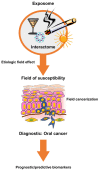Essentials of oral cancer
- PMID: 26617944
- PMCID: PMC4637760
Essentials of oral cancer
Abstract
Oral cancer is one of the 10 most common cancers in the world, with a delayed clinical detection, poor prognosis, without specific biomarkers for the disease and expensive therapeutic alternatives. This review aims to present the fundamental aspects of this cancer, focused on squamous cell carcinoma of the oral cavity (OSCC), moving from its definition and epidemiological aspects, addressing the oral carcinogenesis, oral potentially malignant disorders, epithelial precursor lesions and experimental methods for its study, therapies and future challenges. Oral cancer is a preventable disease, risk factors and natural history is already being known, where biomedical sciences and dentistry in particular are likely to improve their poor clinical indicators.
Keywords: Mouth neoplasms; carcinogenesis; neoplasm staging; oral cancer; oral squamous cell carcinoma; tumor microenvironment.
Figures


References
-
- Barnes L World Health Organization and Cancer IAfRo. Pathology and genetics of head and neck tumours. World Health Organization; 2005.
-
- Warnakulasuriya S. Global epidemiology of oral and oropharyngeal cancer. Oral Oncol. 2009;45:309–316. - PubMed
-
- Dissanayaka WL, Pitiyage G, Kumarasiri PV, Liyanage RL, Dias KD, Tilakaratne WM. Clinical and histopathologic parameters in survival of oral squamous cell carcinoma. Oral Surg Oral Med Oral Pathol Oral Radiol. 2012;113:518–525. - PubMed
Publication types
MeSH terms
LinkOut - more resources
Full Text Sources
Medical
